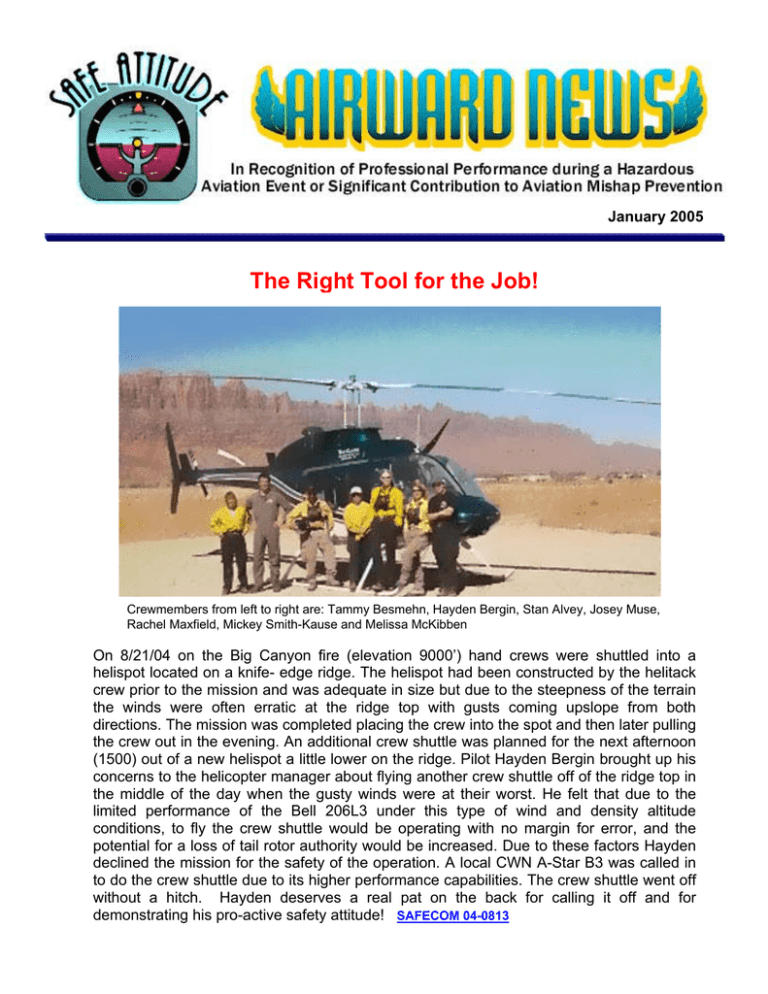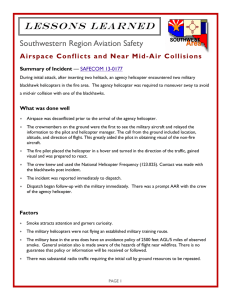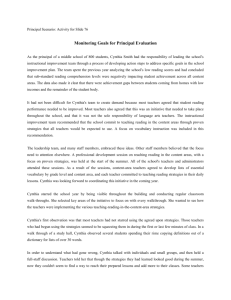The Right Tool for the Job!
advertisement

January 2005 The Right Tool for the Job! Crewmembers from left to right are: Tammy Besmehn, Hayden Bergin, Stan Alvey, Josey Muse, Rachel Maxfield, Mickey Smith-Kause and Melissa McKibben On 8/21/04 on the Big Canyon fire (elevation 9000’) hand crews were shuttled into a helispot located on a knife- edge ridge. The helispot had been constructed by the helitack crew prior to the mission and was adequate in size but due to the steepness of the terrain the winds were often erratic at the ridge top with gusts coming upslope from both directions. The mission was completed placing the crew into the spot and then later pulling the crew out in the evening. An additional crew shuttle was planned for the next afternoon (1500) out of a new helispot a little lower on the ridge. Pilot Hayden Bergin brought up his concerns to the helicopter manager about flying another crew shuttle off of the ridge top in the middle of the day when the gusty winds were at their worst. He felt that due to the limited performance of the Bell 206L3 under this type of wind and density altitude conditions, to fly the crew shuttle would be operating with no margin for error, and the potential for a loss of tail rotor authority would be increased. Due to these factors Hayden declined the mission for the safety of the operation. A local CWN A-Star B3 was called in to do the crew shuttle due to its higher performance capabilities. The crew shuttle went off without a hitch. Hayden deserves a real pat on the back for calling it off and for demonstrating his pro-active safety attitude! SAFECOM 04-0813 Cynthia Speaks Up and gets Managements Attention The actions of Cynthia McCarty during the early stages of the Solstice Complex of fires near Fort Yukon, Alaska contributed to identifying and rectifying potentially serious aviation safety concerns and are worthy of commendation. During the morning aviation conference call of June 23, 2004, and at the request of Incident Commander David Jandt, all fixed wing aircraft flight operations at the Solstice Complex were suspended, including scheduled flights from Fairbanks. This action was taken, in large part, as a result of one individual, Cynthia McCarty, voicing concerns over the safety of aviation operations at the Solstice Complex. A significant number of aircraft were using the Solstice Complex airspace, including an air attack platform, 2 – 3 CL-215’s, a surveillance aircraft, Smokejumper aircraft initial attacking new fires, up to 8 logistics flights per day, and 6 rotor wing aircraft assigned to the complex. Cynthia was assigned as an aircraft radio operator. Over the course of the previous few days, Cynthia had voiced her concern over the lack of a qualified initial attack dispatcher with only herself plus 2 radio operator trainees being expected to schedule, flight follow and document all fixed wing flight operations. Although orders for qualified personnel had been placed, they were not being filled and Cynthia was performing exceptionally in these duties but well beyond what should be expected of a Fire Specialist. On the evening of June 22 Cynthia insisted that the operation was unsafe and that something had to be done immediately to rectify a potentially fatal situation. She pointed out that 3 aircraft had been overdue for flight following call in, a CL-215 had been released from the incident without notifying AICC and that a near miss had occurred between Air Attack and a logistics aircraft arriving from Fairbanks. All of these incidents were preventable and reaffirmed what Cynthia had been trying to bring to the attention of incident managers. Cynthia’s insistence on speaking-up is exactly the kind of action that is spoken of time and time again when aviation safety is addressed in the classroom and in the field. The following excerpt from a lessons learned report from Southern California Firestorm 2003 speaks to Cynthia’s situation precisely. “Speaking-up to offer alternatives or break error chains contributed to the overall ability of senior leaders to make better decisions under stress and prevents accidents.” Southern California Firestorm 2003: An Information Collection Team (ICT) Report for the Wildland Fire Lessons Learned Center, Command and Control Section, Summary of Lessons Learned – Exercising Individual Initiative Due to Cynthia’s diligence, attention to aviation safety concerns and persistence in bringing the issues to “senior leaders”, a potentially disastrous situation was averted. Nice job Cynthia, thanks for speaking up. Helicopter Managers to the Rescue The build up of the helicopter fleet in the Pacific Southwest Region required individuals to manage helicopters under exclusive use agreements rather then CWN agreements. The Region relied upon our CWN managers in most cases to fulfill these positions and in some cases AD employees were used to manage the aircraft. As in any position when taking on new responsibilities the tendency is to focus on your own responsibilities and not take on Darlene Hall and Michael Salas new ones. Two individuals who in addition to managing their own helicopters, sought out trainees to help fill CWN modules. Darlene Hall, Lassen NF and Michael Salas, Los Padres NF assumed management of Type 1 Helicopters on their Forests. Both individuals went out of their way to provide training to new CWN helicopter managers. They accomplished this by ensuring that employees were requested who needed training as managers and then took on the additional responsibility of providing that training. The work they did will benefit the agency in the future, as those they trained become managers themselves. Thanks for all the help Darlene and Mike. Aviation Safety Offices http://www.fs.fed.us/fire/av_safety/ - http://www.oas.gov/oassafty/




